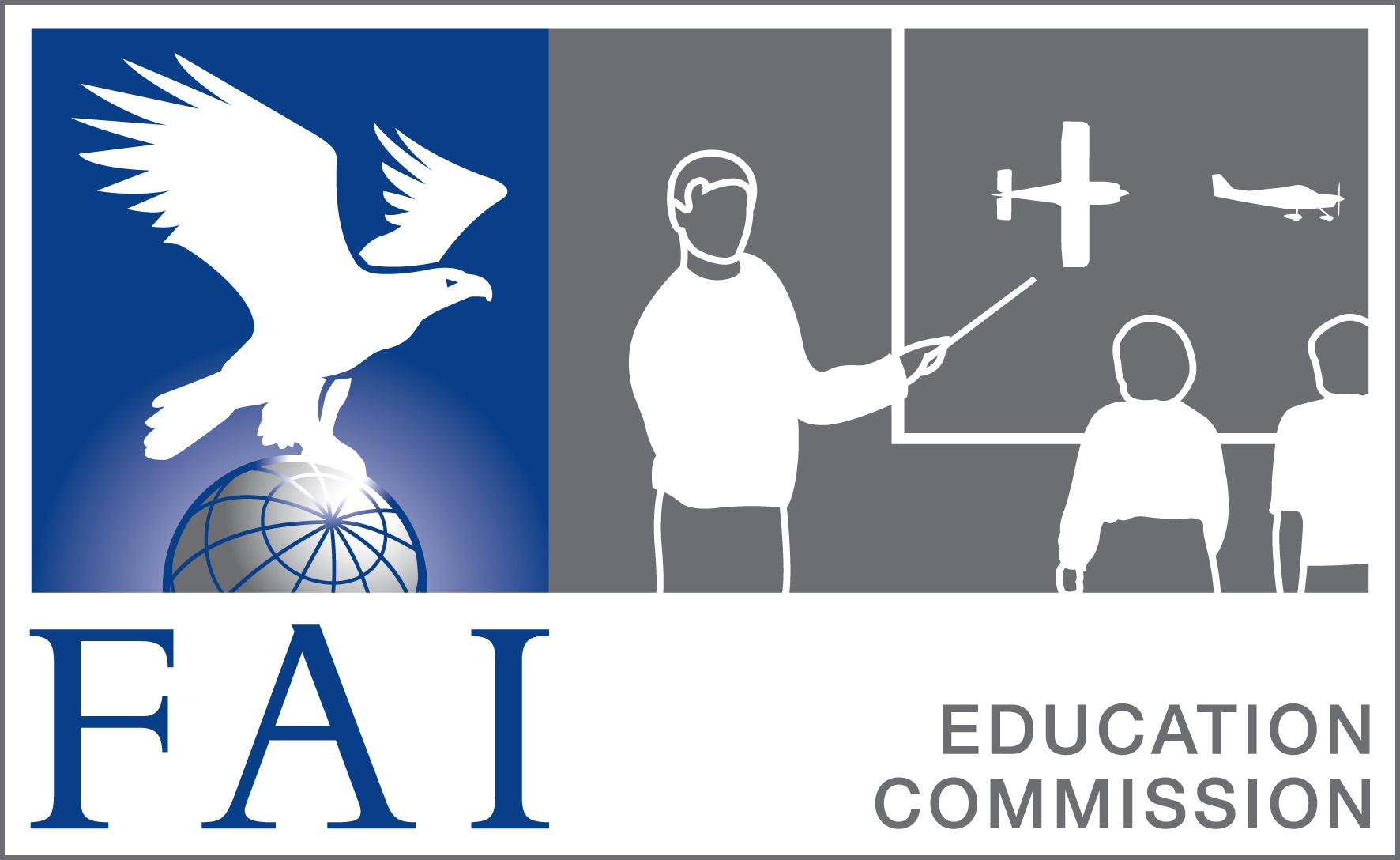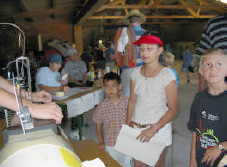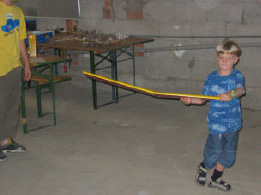
FAI Education Commission (Educ)
Help! Children and youngsters are visiting the airfield...
Klaus Strienz presents ideas for the development of a children and youth program to use for an "open house" at an airfield or at a large field in the community or near a school.
Editor: Klaus Strienz
Contact: Klaus Strienz, director of studies
Translation: M. Dell and Dr. Mervin K. Strickler (USA)
- The content of this web page can be downloaded in PDF format :Help! Children and youngsters are visiting the airfield!
Situation
It is apparent that children and youth are getting bored very fast when they do not have interesting activities to participate in. A realistic demonstration of this concept took place at the airfield “Friesener Warte“ in the north of Bavaria, Germany in July 2003. The editor is responsible for the school service of the German Aeroclub. The program of activities and learning experiences about many phases of aviation were planned and conducted with good teaching and learning practices in mind.
Strategy
The program is a step by step (1-9) approach to learning different aspects of flying. The first exercises explain the phenomena of air characteristics. Further activities explain the technical characteristics of an airplane. Next we introduce aviation communications (aviation terms).
For good educational reasons the activities are arranged in logical sequence. Each participant is given a paper with each numbered activity. The ideal plan is for each participant to visit the activities in the order shown on the paper. However circumstances of a larger group or availability of mentors may require going to activities out of sequence. At the end of the learning stations participants get the “junior pilot license certificate“.
The program was planned and organized in such a manner that the management was carried out by highschool students (Gymnasium Hoechstadt/Germany) and youngsters of the local aeroclub.
Below are the details:
- Registration, description of the activities sequence, photostation for photograph for the “junior pilot license“
- Aerodynamics demonstration using hairdryer and pingpong-ball
- Hairdryer and flat plate – aerodynamic paradox
- Windtunnel
- Demonstration of lift moving a model wing rapidly through the air in a circle
- Constructing a small model plane
- Flightsimulator model –radio controlled – moving through three axes
- Control line modelplane flight demonstration
- Air traffic control communication using ICAO alphabet and wireless walkie-talkie
1. Registration, description of the activities sequence, photostation for photograph for the “junior pilot license“

Description
The participants get their sequence papers here to take part in the program to receive the junior pilot certificate. A photo will be taken which will be part of the license.
Materials needed
Sequence papers with information to be learned on the topics and que stions to be answered, junior pilot license forms, computer, printer, digital camera, (goggles and pilot hat provide atmosphere ??). Table and chairs.
Safety requirements and cautions, number of students needed
Don’t print the pilot license until the participant has finished the sequence.
Needed: 2 students.
2. Aerodynamics demonstration using hairdryer and pingpong-ball

Description
In the lift of the hairdryer the pingpong-ball will fly. Even when you move the hairdryer the ball will follow.
Materials needed
Hairdryer with sufficient force, a vacuum cleaner can also be used (reverse flow), pingpong-balls, extension cord, table and chair.
Safety requirements and cautions, number of students needed
For hairdryer switch on cold rather than hot air; hold hairdryer away from the clothing which can be taken into the intake of the dryer!
1 student needed.
3. Hairdryer and flat plate – aerodynamic paradox
Description
The high speed airflow at the end of the pipe causes a low pressure around the base of the pipe and produces positive force on a plate and causes lift.
Materials needed
Hair dryer, pipe, plates of balsawood or foam, extension cord, table, chair.
Safety requirements and cautions, number of students needed
For hairdryer switch on cold rather than hot air; hold hairdryer away from the clothing which can be taken into the intake of the dryer!
1 student needed.
4. Windtunnel

Description
A potentiometer manipulates the fan and airflow. In front of the tube an airfoil is suspended by tethers.
Materials needed
Table, extension cord, fan, tube, wing, tethers.
Safety requirements and cautions, number of students needed
Keep away from the intake of the fan.
1 student needed.
5. Demonstration of lift moving a model wing rapidly through the air in a circle

Description
Because of the speed the air produces lift which can be felt by hand. Changing the turn-around speed and the angle of attack,the lift can be manipulated.
A very motivatingexercise.
Materials needed
Solid model plane wing.
Safety requirements and cautions, number of students needed
Safe demonstration flight platform.
In the beginning the participants will not detect which part of the wing will be up or in the front.
Help: big photo, structure plan of a bird’s wing which demonstrates the curve and flight direction.
6. Constructing a small model plane

Description
Supervised participants are construc ting a small modelplane out of balsawood or foam.
Materials needed
Several tables and many seats, material on which to work to protect the table, hot-glue-pistol, 2 markers to identify each model, enough material , sharp knives, first-aid material, balance weights (not lead = poison!), construction frames to use in building the plane.
Safety requirements and cautions, number of students needed
Provide construction planes for the students and parents to take home, plan an area for students to bring models that need repaired, construction frames and jigs should be big enough, otherwise children will have disappointing problems, Explain the function of grain in the wood in model construction, mark the grain with an arrow! Have a completed model with descriptions of the airplane parts, the center of gravity and the grain in the middle of the work area.
Students: only well experienced students should be used to supervise and assist the construction and first flight, children should not play with tools and knives.
Needed students: 4 experienced students.
7. Flightsimulator model –radio controlled – moving through three axes.


Description
A radiocontrolled model – mounted on a pin – to allow controls to operate on each axis (rudder, ailerons, elevators and engine).
Safety requirements and cautions, number of students needed
Radiocontrol system included model and controls (builder: Alfred Dutz, Model flying group Hoechstadt / Bavaria / Germany).
Needed: 1 student operator.
8. Control line model plane flight demonstration.

Description
An electropowered model flies around a pole with 2 bearings which allow the pole to turn with the plane (adopted from the Deutsches Museum), pilot tries to land the model in a specified space using a speed control (builders: Erwin Weschta and Alfred Dutz (model flying group Hoechstadt).
Materials needed
Model planes, two poles, energy cord, potentiometer, tape for outlining landing area or colored marker, table and chairs.
Safety requirements and cautions, number of students needed
Safety fence (snow fence), only controlled access.
Needed: 2-3 students.
9. Air traffic control communication using ICAO alphabet and wireless walkietalkie
Description
Participant is sitting in the cockpit of a glider or airplane or realistic simulator and transmits his name using the ICAO-alphabet to the “tower“.
Materials needed
Cockpit, walkie-talkies, ICAO-alphabet sheet, table for the tower to write down the received message.
Safety requirements and cautions, number of students needed
Protect instruments and controls in the real cockpit, check walkietalkies in advance and have replacement batteries.
Needed: 2 students.
Any visit to an aviation activity like these demonstrates the high interest of children and youth who are participating.
Use this material at your own risk. Observe cautions and safety rules. This collection will be continued.
Version1.0

